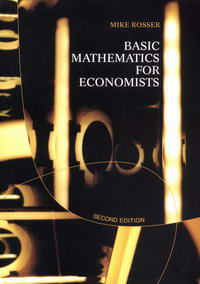Basic Mathematics for Economists, изд. 2
| Автор(ы): | Rosser M.
06.10.2007
|
| Год изд.: | 2003 |
| Издание: | 2 |
| Описание: | Economics students will welcome the new edition of this excellent textbook. Given that many students come into economics courses without having studied mathematics for a number of years, this clearly written book will help to develop quantitative skills in even the least numerate student up to the required level for a general Economics or Business Studies course. All explanations of mathematical concepts are set out in the context of applications in economics. This new edition incorporates several new features, including new sections on: financial mathematics; continuous growth; matrix algebra. |
| Оглавление: |
 Обложка книги.
Обложка книги.
1.1 Why study mathematics? 1.2 Calculators and computers 1.3 Using the book 2 Arithmetic 2.1 Revision of basic concepts 2.2 Multiple operations 2.3 Brackets 2.4 Fractions 2.5 Elasticity of demand 2.6 Decimals 2.7 Negative numbers 2.8 Powers 2.9 Roots and fractional powers 2.10 Logarithms 3 Introduction to algebra 3.1 Representation 3.2 Evaluation 3.3 Simplification: addition and subtraction 3.4 Simplification: multiplication 3.5 Simplification: factorizing 3.6 Simplification: division 3.7 Solving simple equations 3.8 The summation sign J2 3.9 Inequality signs 4 Graphs and functions 4.1 Functions 4.2 Inverse functions 4.3 Graphs of linear functions 4.4 Fitting linear functions 4.5 Slope 4.6 Budget constraints 4.7 Non-linear functions 4.8 Composite functions 4.9 Using Excel to plot functions 4.10 Functions with two independent variables 4.11 Summing functions horizontally 5 Linear equations 5.1 Simultaneous linear equation systems 5.2 Solving simultaneous linear equations 5.3 Graphical solution 5.4 Equating to same variable 5.5 Substitution 5.6 Row operations 5.7 More than two unknowns 5.8 Which method? 5.9 Comparative statics and the reduced form of an economic model 5.10 Price discrimination 5.11 Multiplant monopoly Appendix: linear programming 6 Quadratic equations 6.1 Solving quadratic equations 6.2 Graphical solution 6.3 Factorization 6.4 The quadratic formula 6.5 Quadratic simultaneous equations 6.6 Polynomials 7 Financial mathematics: series, time and investment 7.1 Discrete and continuous growth 7.2 Interest 7.3 Part year investment and the annual equivalent rate 7.4 Time periods, initial amounts and interest rates 7.5 Investment appraisal: net present value 7.6 The internal rate of return 7.7 Geometric series and annuities 7.8 Perpetual annuities 7.9 Loan repayments 7.10 Other applications of growth and decline 8 Introduction to calculus 8.1 The differential calculus 8.2 Rules for differentiation 8.3 Marginal revenue and total revenue 8.4 Marginal cost and total cost 8.5 Profit maximization 8.6 Respecifying functions 8.7 Point elasticity of demand 8.8 Tax yield 8.9 The Keynesian multiplier 9 Unconstrained optimization 9.1 First-order conditions for a maximum 9.2 Second-order condition for a maximum 9.3 Second-order condition for a minimum 9.4 Summary of second-order conditions 9.5 Profit maximization 9.6 Inventory control 9.7 Comparative static effects of taxes 10 Partial differentiation 10.1 Partial differentiation and the marginal product 10.2 Further applications of partial differentiation 10.3 Second-order partial derivatives 10.4 Unconstrained optimization: functions with two variables 10.5 Total differentials and total derivatives 11 Constrained optimization 11.1 Constrained optimization and resource allocation 11.2 Constrained optimization by substitution 11.3 The Lagrange multiplier: constrained maximization with two variables 11.4 The Lagrange multiplier: second-order conditions 11.5 Constrained minimization using the Lagrange multiplier 11.6 Constrained optimization with more than two variables 12 Further topics in calculus 12.1 Overview 12.2 The chain rule 12.3 The product rule 12.4 The quotient rule 12.5 Individual labour supply 12.6 Integration 12.7 Definite integrals 13 Dynamics and difference equations 13.1 Dynamic economic analysis 13.2 The cobweb: iterative solutions 13.3 The cobweb: difference equation solutions 13.4 The lagged Keynesian macroeconomic model 13.5 Duopoly price adjustment 14 Exponential functions, continuous growth and differential equations 14.1 Continuous growth and the exponential function 14.2 Accumulated final values after continuous growth 14.3 Continuous growth rates and initial amounts 14.4 Natural logarithms 14.5 Differentiation of logarithmic functions 14.6 Continuous time and differential equations 14.7 Solution of homogeneous differential equations 14.8 Solution of non-homogeneous differential equations 14.9 Continuous adjustment of market price 14.10 Continuous adjustment in a Keynesian macroeconomic model 15 Matrix algebra 15.7 Introduction to matrices and vectors 15.2 Basic principles of matrix multiplication 15.3 Matrix multiplication - the general case 15.4 The matrix inverse and the solution of simultaneous equations 15.5 Determinants 15.6 Minors, cofactors and the Laplace expansion 15.7 The transpose matrix, the cofactor matrix, the adjoint and the matrix inverse formula 15.8 Application of the matrix inverse to the solution of linear simultaneous equations 15.9 Cramer's rule 15.10 Second-order conditions and the Hessian matrix 15.11 Constrained optimization and the bordered Hessian Answers Symbols and terminology |
| Формат: | djvu |
| Размер: | 3688291 байт |
| Язык: | ENG |
| Рейтинг: |
312
|
| Открыть: | Ссылка (RU) |